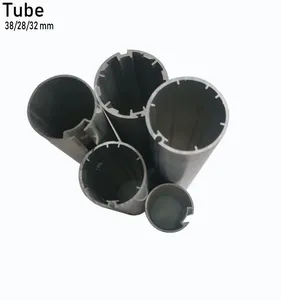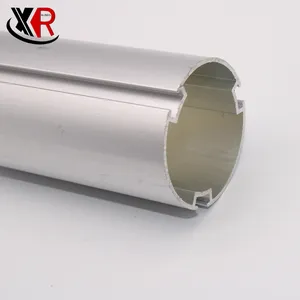
All categories
Featured selections
Trade Assurance
Buyer Central
Help Center
Get the app
Become a supplier

(6384 products available)




















































Various kinds of roller blind tubes are available, each with distinct features and benefits, and these accommodate different requirements and preferences. The most frequently used materials for roller blind tubes are metal, plastic, and aluminum.
Standard metal tubes:
Standard metal tubes are commonly used for roller blinds. These tubes are made of steel or iron and are strong and durable. They can support heavy blinds and are ideal for big windows or commercial spaces. Standard metal tubes have a diameter of 25mm, 32mm, or 40mm, which can hold heavy blind fabrics. They are usually found in offices, schools, and public buildings where long-lasting and dependable blinds are needed. These tubes can handle wear and tear and are a good investment for places that require strong blinds.
Aluminum tubes:
Aluminum tubes for roller blinds are made from aluminum material, which is light and resistant to rust. These tubes are suitable for both residential and commercial settings where a lightweight and corrosion-resistant option is needed. Aluminum tubes can come in different sizes to fit various blind systems. They can have a diameter of 25mm to 100mm. The thickness can be from 0.8mm to 1.5mm. They are often used in home blinds and office blinds. They are also used in special applications like solar shades or projection screens. Aluminum tubes provide a modern look and are environmentally friendly since aluminum can be recycled easily.
Plastic tubes:
Plastic tubes for roller blinds are made from durable plastic materials like PVC or polypropylene. These tubes are a low-cost option, lightweight, and easy to maintain. Plastic tubes are commonly used in smaller windows or where less stress is expected. They come in different colors and finishes, making them suitable for decorative purposes. Plastic tubes are also used in special applications like children's rooms, where safety and ease of use are important.
Specialized tubes:
Specialized tubes for roller blinds include different kinds of tubes designed for specific uses. These tubes can have special features to make them easier to use or install. Some examples are:
Motorized tubes have small motors inside them to move the blinds up and down automatically. These tubes are great for hard-to-reach windows or when a modern look is desired. They can be controlled using a remote control, wall switch, or smart home system.
Spring-loaded tubes have strong springs inside them. They help roll the blind fabric up and down smoothly. These tubes are compact and simple to use. They are suitable for small blinds where space is limited. Spring-loaded tubes are commonly used in cafes, restaurants, and small offices.
Double roll-up tubes allow two different kinds of blinds to be used together on the same window. Each tube can hold a different blind fabric, so users can switch between them as needed. This setup is often seen in places where people want to change the look or light quickly, like in hotels or showrooms.
Various elements make roller blind tubes function well and last long, such as the materials, sizes, and construction methods. Different designs of roller blind tubes have different advantages, and the choice depends on the use and desired aesthetics.
Materials:
Most commonly, metal roller blind tubes are made of materials like aluminum because it is light and does not cost much. It is also strong and can withstand damage in places with a lot of sunlight. PVC is another material used to make tubes, especially when less weight is needed and costs must be kept low. Steel is sometimes used for large or heavy window blinds. It offers good strength and support. Composite materials, which include fibers and special plastics, are used to make high-end window blinds. These composites are very strong but light, and they do not bend or change shape over time.
Sizes and dimensions:
Diameter size is an important factor when choosing roller blind tubes. They usually come in different diameters, such as half an inch, one inch, one and a half inches, or two inches. The size of the window blind fabric determines the size of the tube that should be used. Larger tubes are good for bigger blinds since they roll up the fabric easily without causing folds or wrinkles. The width of the tube must also be considered. It should match or be wider than the window blind fabric so that it fits well on the window or covering. The length of the tube must correspond with the width of the installation area so that it does not hang out or cover too little space. The blind tube must also have enough length to reach from the top to the bottom of the window. Many tubes are adjustable in size so that they can fit different windows without any problems.
Construction methods:
Metal roller blind tubes, especially those made of aluminum, are constructed using extrusion. In this method, metal is forced through a shaped opening to create long pieces with specific shapes. PVC tubes are made by molding plastic materials together to form hollow cylinders. Steel tube construction involves welding metal sheets together, while composites are layered and bonded using special adhesives.
Commercial Settings:
In offices, shops, and schools, the blind tubes are used to hold and operate the window shades. They are important for controlling the amount of sunlight that comes in and for privacy. The blinds attached to these tubes reduce glare on computer screens and displays, which makes it easier to see everything clearly. They also help keep rooms cool by blocking out the sun during hot parts of the day.
Residential Use:
In homes, roller blind tubes support window coverings that add to the decoration and privacy of a room. Different fabric choices and colors on the blinds attached to these tubes can match or improve a home's interior design. Additionally, the blinds can help with energy savings by preventing heat loss or gain through the windows.
Healthcare Facilities:
In hospitals and clinics, the blind tubes are used to operate window coverings that help create calm spaces for patients. The ability to easily raise or lower the blinds gives control over how much natural light comes in, which is important for patient comfort and healing. Blinds that filter sunlight from these tubes can help reduce harsh lighting while still allowing soft, diffused light into the room.
Hospitality Industry:
Hotels and restaurants use roller blind tubes to operate stylish window coverings that improve guest comfort. The blinds provide privacy and can be easily adjusted to let in just the right amount of sunlight, creating a pleasant atmosphere. In places where there is a lot of sunlight, blinds on these tubes help keep rooms cool and comfortable for visitors.
Educational Institutions:
Schools use the blind tubes to hold window shades in classrooms and other areas. The ability to roll up or down the blinds helps teachers control sunlight so that it does not bother students' eyesight. Blinds covering windows in schools can help reduce glare on writing boards and screens used for lessons, making learning easier for everyone.
When choosing roller blind tubes, the following factors should be considered:
Material of Tube:
Metal tubes are good for heavy or wide blinds because they can carry the weight well. They also last a long time and are good for big blinds. Plastic tubes are lighter and cheaper, making them suitable for smaller blinds. They are also good if one wants to change the color or design of the blind.
Size and Fit:
It is important to measure the window blind tube size correctly to ensure that the tube fits the blind material and the window. A good fit makes the blind work well and look nice. The tube should be the right size so the blind rolls up and down easily and hangs flat.
Durability and Maintenance:
Metal tubes need less care and last a long time, but plastic tubes can break or get dirty more easily. Choose a tube that will last and be easy to look after based on the materials used and how the blind will be used.
Ease of Installation:
Some tubes are easier to put in than others. If one is doing it oneself, choose a tube with simple steps. Some suppliers provide clear instructions and helpful tools to make the installation process easier.
Cost:
Tube costs vary based on material and size. Plastic tubes cost less, but metal tubes may be worth it if they last longer. Do not forget to consider the total cost, including extra costs for installing and caring for the blind.
Q1: What are the trends in roller blind tube design?
A1: Minimalistic designs with clean lines and concealed mechanisms are gaining traction. Metallic finishes and unique textures are becoming more popular. Modular systems that allow for customization and easy installation are trending.
Q2: What are the standard diameters for roller blind tubes?
A2: The common diameters are 25mm, 32mm, 40mm, and 60mm. The choice depends on the size of the blind and the weight of the fabric.
Q3: How can roller blind tubes be eco-friendly?
A3: Tubes made from recycled materials or sustainable bamboo are eco-friendly. Tubes that can be reused or upgraded without replacing the entire blind are also eco-friendly.
Q4: What do the customizations for roller blind tubes include?
A4: Roller blind tubes can be customized in color, finish, and length. They can also be customized with logos or designs to match the decor or brand identity.
Q5: What is the expected lifespan of a roller blind tube?
A5: The lifespan varies with the material and usage. Metal and plastic tubes can last several years. Regular maintenance can also prolong their lifespan.